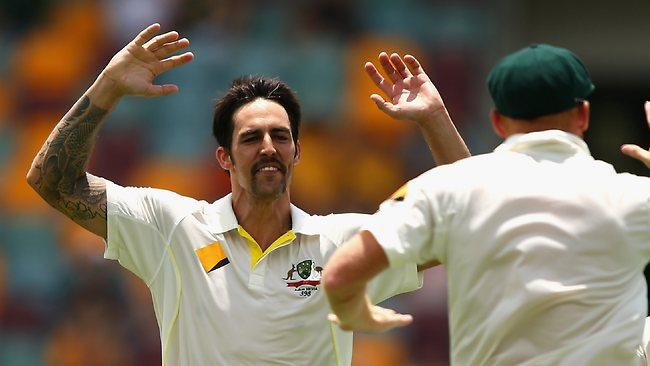10 reasons Lehmann's Australians have the upper hand
DARREN LEHMANN'S optimistic claims that the return series would suit his players better don't look so foolish now.

DARREN LEHMANN'S claims don't look so foolish now. Towards the fag-end of the tour of England, Australia's coach claimed that his team - without a Test win in two away series - were in good shape and not far from turning a corner. He believed that with the return series taking place on home soil, in conditions that would suit his players better, there was genuine cause for optimism.
Not everyone agreed; some pundits - admittedly English ones - thought England could win 5-0 but the first three days in Brisbane suggest Lehmann may have been spot-on. After years of instability and chaotic selection, Australia are showing signs of thinking clearly again and have already landed several tactical blows that could stand them in good stead throughout the series.
1) AUSTRALIA'S STRONG INTENT
England's batting was often painstaking in the summer but they promised to be better here. In fact, Australia's batsmen started the busier, especially against Graeme Swann, and were not afraid to play their shots. This approach was typified by David Warner, who pulled his first ball for four, and Brad Haddin, who went hard even when he had a century in his sights. Yesterday Michael Clarke scored a hundred in 115 balls. England's rate, by contrast, was often sclerotic, almost grinding to a halt on Friday when they lost six wickets for 39.
2) HEIGHT ISN'T EVERYTHING
England came to Australia with a plan that tall, fast bowlers would be king, bringing with them four who stand between 6ft 6in and 6ft 8in. Stuart Broad shows there is merit in the idea but Chris Tremlett's selection looks like a woeful error. Three years ago Australia's batsmen were apprehensive of him but there was nothing to fear here.
None of Australia's three quicks touch 6ft 2in - Ryan Harris is only 5ft 10in - yet they had England on the rack.
3) ENGLAND HAVE A PROBLEM WITH THEIR OPENERS
The likeliest route to England getting back to posting first-innings scores of 400 would be if their opening pair fired, but since Andrew Strauss retired they have struggled to settle on a combination that works. Michael Carberry, the latest partner for Alastair Cook, battled gamely in the first innings but reined in his game to such an extent that he became virtually strokeless. If he plans to wait for bad balls, he may wait a long time. Including his 14-ball duck yesterday, he has scored one run off the last 53 balls he has faced. In six Ashes Tests, England's first wicket averages 24.6. Not good enough.
4) JONATHAN TROTT IS IN TROUBLE
In happier times, Trott was a vital calming influence, taking possession of the crease like a man building a dam, but Australia have found a line of attack that has disrupted that serenity. He insisted he had been working in the nets with Ashley Giles but in both innings in Brisbane it was clear nothing had changed: he has no idea how to deal with balls directed at his body from a leg-stump line. Instead he shuffles across and flaps his bat towards leg. No one has walked more willingly to the gallows.
5) MITCHELL JOHNSON: NO LAUGHING MATTER
Australia's hopes rest heavily on Johnson, the fastest bowler on either side. In the past he would have struggled to cope with such expectation but he has put together three good days in a row with bat and ball. His first spell of the match was poor but he got lucky with Trott's wicket and gained confidence from there. England's unease at facing him - and their decision during the warm-up phase to fly in left-armers to practise against - can only have encouraged him further. It can't last, can it?
6) AUSTRALIA HAVE THE FASTER BOWLERS
Unless Tremlett, Steven Finn or Boyd Rankin shortly show themselves capable of bowling at the speed of light, Australia are going to hold a decisive edge. Johnson and Harris can both top 90mph and there is little to stop them roughing up England's bowlers because they won't much fear retaliation. Speed may not be decisive at every venue but it could go a long way to delivering Australia a win in Perth.
7) GRAEME SWANN IS UNDER FIRE
Australia's decision to pack the middle order with right-handers worked well in England and paid off again in Brisbane, where the left-handers Warner and Johnson also got stuck in. Johnson's partnership of 114 with Haddin on the first day arguably turned the game. The theory that the pitch was not conducive to spin was undermined when Nathan Lyon extracted greater bounce to dismiss Ian Bell and Matt Prior. Swann's match figures were among his worst.
8) AUSTRALIA ARE CAPABLE OF WINNING KEY PASSAGES
One of the main criticisms of Australia in England was that they failed to win key passages of play. Well, they won several in Brisbane after making what appeared to be a below-par 295 in the first innings and then bowling poorly at the start of England's reply. The game was in the balance at lunch on day two but after stern words in the dressing room they came out and bowled with tremendous purpose before driving home their advantage with the bat.
9) THE AUSTRALIAN FANS CAN PLAY A PART
Despite numerous attempts to provoke them, England dealt coolly with various verbal attacks in the lead-up to the series, and even with the hostility of the crowd on the first day. However, once they started losing wickets, and the atmosphere inside the stadium became more febrile, full-scale panic set in. The Australian public can turn on their own if the team struggle but after such a great start by their side, loyalty looks guaranteed.
10) AUSTRALIA MAY HAVE THE BETTER ANALYSTS
For years, England's preparation was regarded as second to none, but since Lehmann took over Australia's plans have appeared no less thorough. They seem to have got a precise hold on where the flaws in England's game are located and for that much credit must go to the team's analyst, Dene Hills, who used to work for the ECB. The England camp must be disconcerted to find themselves so comprehensively rumbled.
The Sunday Times


